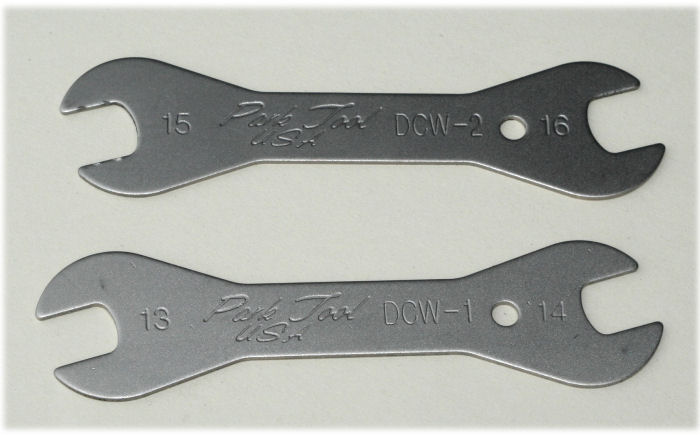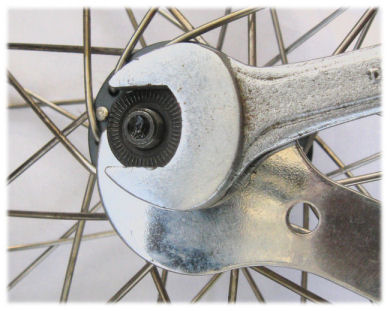What Size Cone Wrench Do I Need
Reports of the demise of this Web site are greatly exaggerated! Nosotros at sheldonbrown.com give thanks Harris Cyclery for its support over the years. Harris Cyclery has airtight, but nosotros keep going. Proceed visiting the site for new and updated articles, and news about possible new affilations.


(A Blast From The By)
This is an old commodity, and some of the information in it is obsolete.
This article originally appeared in Bicycling magazine, August, 1982
[Comments in brown are second thoughts, 1998.]
Inappreciably obsolete at all, though revised to comprehend cartridge bearings
past John "Plus ça change" Allen, July, 2010
Cone Wrenches
Some special wheel tools are time- and labor- savers for jobs that could be washed with standard tools; other special tools are absolutely necessary to do sure jobs. Amongst the essential special tools are cone wrenches. No standard tools tin take their place.
Cone wrenches are similar to ordinary double-ended open-end wrenches , except that they are much thinner. A typical good quality fourteen-millimeter open-cease wrench or half dozen-inch adjustable wrench is about vii millimeters (0.28-inch) thick; cheap wrenches are thicker nevertheless. Cone wrenches, however, are unremarkably only two millimeters (0.08-inch) thick.

In well-nigh cases, a standard open-stop or adjustable wrench can be used for cone locknuts, but the cones themselves can be adjusted only with a cone wrench, because of narrow flats and close clearances.
Tightening a hub locknut confronting the cone

Cone wrenches commonly come in thirteen x fourteen-millimeter, fifteen 10 xvi-millimeter, and 17 10 18-millimeter sizes. If you lot intend to practise your own maintenance, you should have at to the lowest degree one and preferably two of each size needed for your hubs. The safest way to buy cone wrenches is to ride your bicycle to a well-stocked bicycle shop and cheque the fit as you are buying the wrenches.
Cheap tools are never a bargain, and this is especially truthful of cone wrenches. Because of their farthermost thinness for the nut sizes they fit, cone wrenches must be made of especially high-quality steel to stand up to the normal stresses that they will exist subjected to in use. Junior cone wrenches will bend, often the first time that they are used, and so get useless.
![]()
![]()
Campagnolo Quality
As with so many other bicycle tools and parts, Campagnolo is the standard for comparing. I have been using my Campagnolo wrenches for 12 or xiii years now, and they still fit as well as they did when they were new. I bought the Campagnolo wrenches after going through several sets of cheap French cone wrenches in just a few' months of professional use. At that fourth dimension, I could find nothing else that would hold up to serious utilize.
In the past few years, nonetheless, quite serviceable cone wrenches have get available from American and Japanese manufacturers at reasonable prices. In full general, y'all will get better quality tools if you purchase them individually, rather than ownership a pre-packaged "wheel tool kit."
Schwinn makes peculiarly good cone wrenches for shop use. They are single-ended, with a comfortable plastic-coated handle. Unfortunately, since they are unmarried concluded, you need to purchase ten of them to get two each of the five mutual sizes. (I have notwithstanding to detect a need for the 18-millimeter end of my 17 x 18-millimeter wrench).
[The brand recommendations in a higher place are very out-of-engagement. My current favorite is the Park laser-cutting (blackness finish) shop model.]

In that location are times when two cone wrenches of the same size are essential -- for instance, Campagnolo Record rear hubs use a fourteen-millimeter wrench for both the cones and the locknuts; the locknuts accept narrow flats and taper in such a mode that you must use a cone wrench for the locknut as well as for the cone.
Faster With Two
Even when two identical cone wrenches are not essential, they are a peachy assist in adjusting the cones rapidly and exactly.
If yous do not have 2 of each needed size, to make even the smallest alter in the cone adjustment, you must first loosen the locknut, then adjust the cone, so re tighten the locknut. If you lot go the cone aligning just correct simply the locknut is not sufficiently tight, tightening the locknut volition throw the cone aligning off. Careful cone adjustment by this technique is a very time-consuming process of trial and error.
If you have two wrenches of each needed size, the fine adjustment tin can be washed much more quickly and easily! Starting time, get the cones in roughly correct aligning, with the locknuts fairly tight. Now, if the cone adjustment is too tight, put a wrench on each cone and dorsum the cones away from each other.
This will simultaneously loosen the cone adjustment and further tighten the locknuts. If the cone adjustment is a bit too loose, put a wrench on each locknut and tighten them together. This volition tighten both the cone adjustment and the locknuts at the same time. This approach volition enable yous to make very modest adjustments to the cones without loosening the locknuts.
There is a supposedly non-rotating washer between each cone and locknut, which you lot might remember would go on this system from working, but it does not in do, as long as you commencement with a reasonably skilful rough adjustment.
Reduce Play
The correct adjustment for solid-beam hubs is to get the cones tight plenty to reduce play to a minimum without causing the axle to bind when turned. You should first judge the freeness of the bearing when the cones are likewise loose, so that in that location is a little flake of play.
Pretend that you are a safecracker and that the axle is the knob of a safe. Hold the axle past a cone locknut very gently with your fingertips. Circumduct the axle slowly several revolutions. Practise this by turning your wrist, not by rolling the axle in your fingers. You should experience almost no resistance, and no unevenness in the rotation.
If in that location is roughness or unevenness with the bearings adapted loose, it means that your bearing surfaces are damaged, your axle is bent, or in that location is strange matter (dirt) in the bearings.
If it turns smoothly and without resistance with the cones loose, remember how that feels. Tighten the cones bit by bit until y'all experience slightly increased resistance, and so back the adjustment off simply enough to become rid of the resistance.
At this betoken, there should be no noticeable play in the axle. if y'all cannot eliminate almost all of the play from the beam without causing the bearings to bind, the hub needs to be cleaned and repacked, possibly with some new parts.
Some hubs with sealed cartridge bearings take double locknuts on each cease. The axle generally has a flange inboard each bearing. The begetting'southward inner race is clamped betwixt this flange at the inside and the inner locknut at the exterior. The cartridges use radial-contact bearings: that is, the bearing balls ride in the bottom of rounded grooves in the inner and outer raceways, rather than on angled surfaces as in cup and cone bearings.
(How do they get the bearing balls in, you may ask? By placing the races eccentrically from one some other, so there is a large space on one side -- introducing bearing assurance simply on that side, so spacing the begetting assurance evenly and snapping a retainer into identify to hold them in position. )
Despite the locknuts, this kind of hub is non-adaptable. It should turn freely, and if installed in a wheel, at that place should be a very slight amount of play at the rim. If it binds, that is probably because the bearing balls are riding on the side of the raceway. This tin can occur if the cartridge is non properly seated due to clay or burrs, or if the axle is not exactly right for the hub.
![]()
![]()
Compressing the Axle
If you have quick-release hubs, this is just the starting signal. When the quick-release skewer is tightened, it slightly compresses the beam, making the cone adjustment tighten. If your cones are perfectly adapted with the skewer loose, they will become also tight once the wheel is installed and the quick release is tightened.
To recoup for this, cones on quick-release hubs must be adapted and then that in that location is a little chip of play when they are not on the bicycle. The very final tightening is done with the quick-release skewer When the cones are properly adjusted on a quick-release wheel, there should be slight bearing play if the quick-release skewer is only partially tightened. This play should just disappear once the quick-release is fully tightened. My article on cone aligning describes a special tool that compresses the axle, avoiding the need for trial-and-error adjustment.
Beam pinch is a particular trouble with some cartridge-bearing hubs, considering these are non-adaptable. The better cartridge-bearing hubs have an extra-rigid big-bore beam.
Avert Corruption!
Because cone wrenches come in mostly useful sizes, and are very light, it is often tempting to use them for other purposes, such equally saddle adjustments and tightening axle nuts or even pedals. Resist this temptation! These tools are merely for cones, and any other use constitutes abuse of a fine tool. All of these other uses require substantially more than torque than is needed for cone adjustments, and these thin wrenches are not fabricated for such heavy utilise. Skillful quality tools should terminal a lifetime if properly cared for.
![]()
See too my newer article on Cone Adjustment
![]()
More than Tool Tips
![]()
![]()
- What's New
- Sheldon Brownish on Facebook
- Site Feedback & Questions
Reports of the demise of this Spider web site are profoundly exaggerated! Nosotros at sheldonbrown.com thank Harris Cyclery for its support over the years. Harris Cyclery has closed, but nosotros go on going. Proceed visiting the site for new and updated articles, and news about possible new affilations.
Copyright © 1983, 2007 Sheldon Brownish
Harris Cyclery Habitation Folio
If you would like to make a link or bookmark to this folio, the URL is:
http://sheldonbrown.com/tooltips/conewrenches.html
Final Updated: past Harriet Fell
What Size Cone Wrench Do I Need,
Source: https://www.sheldonbrown.com/tooltips/conewrenches.html
Posted by: jarmansivionts35.blogspot.com


0 Response to "What Size Cone Wrench Do I Need"
Post a Comment